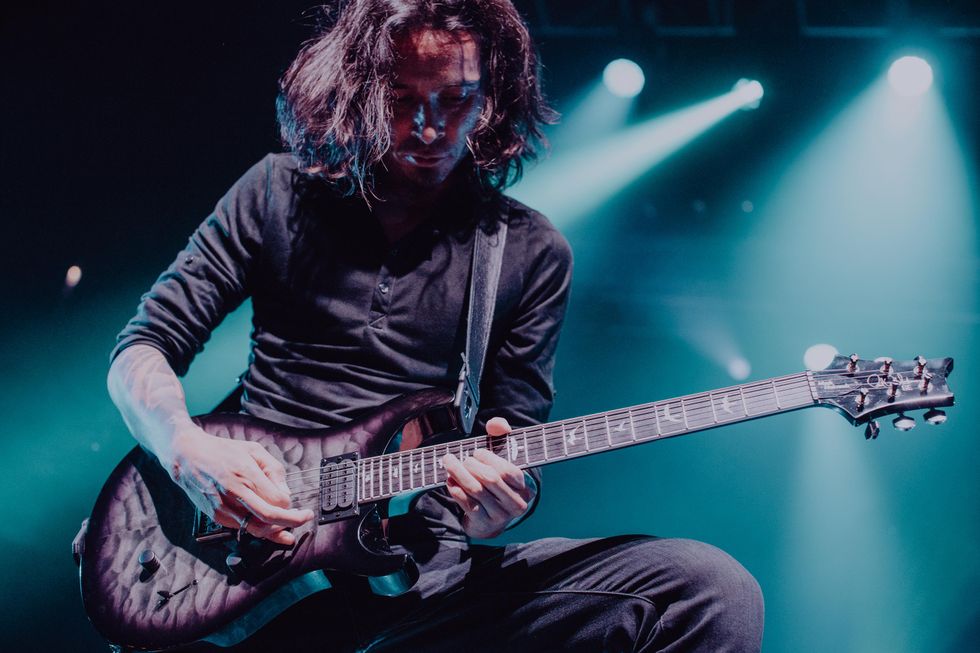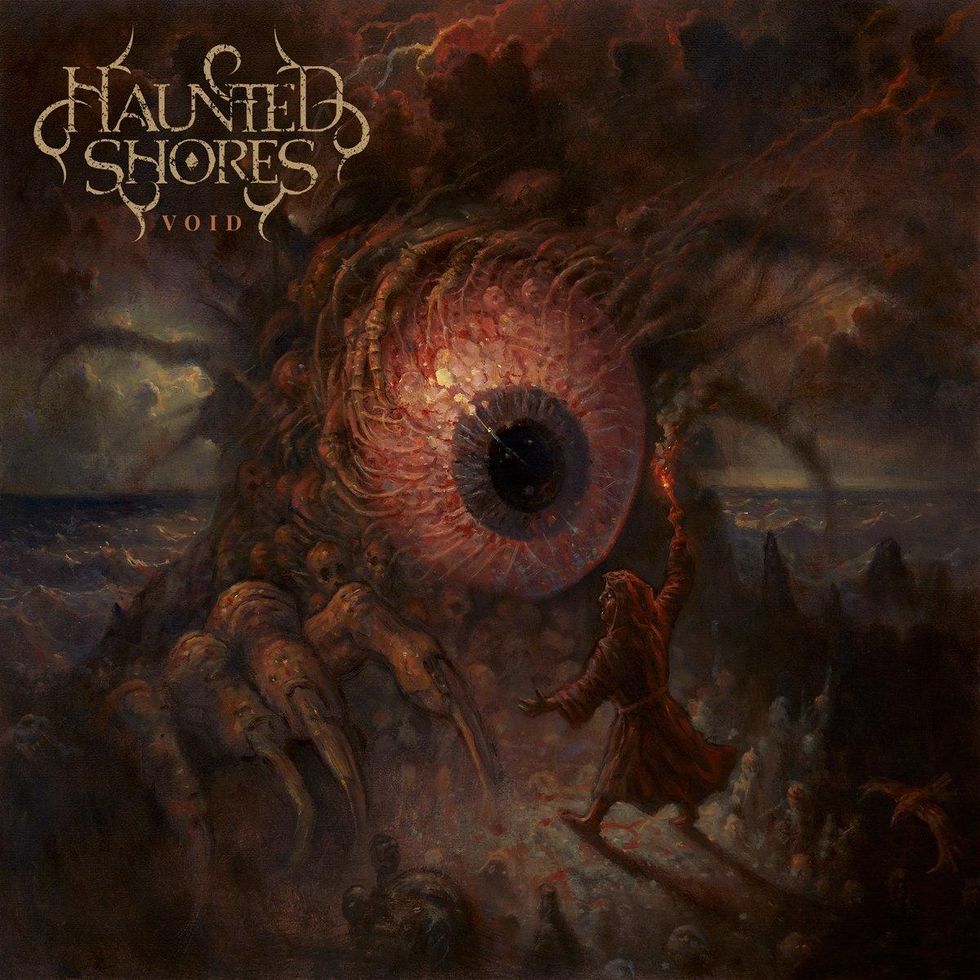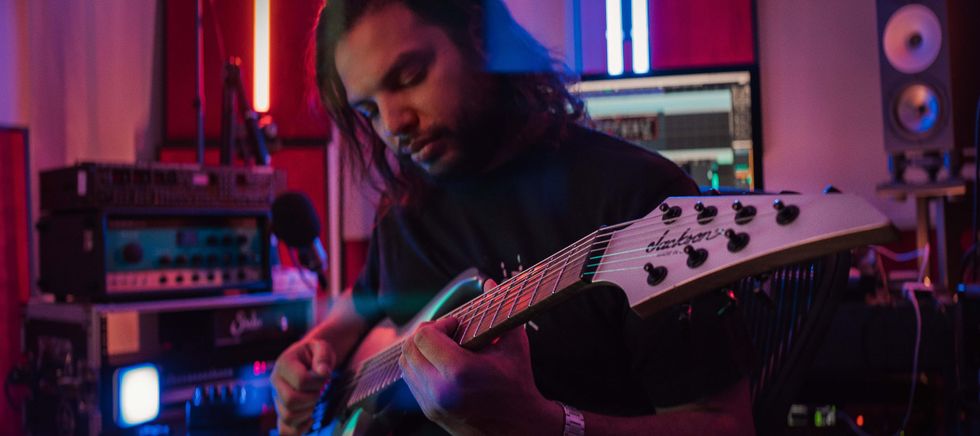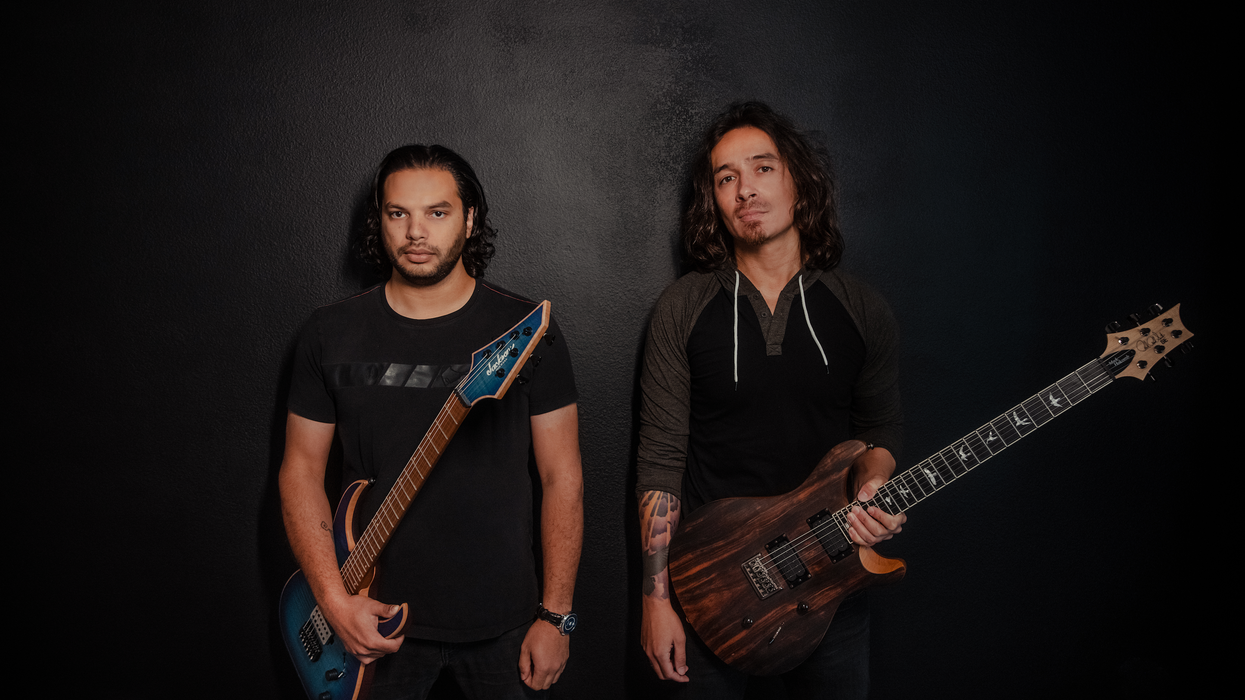As two thirds of the triumvirate of guitarists that provides taste-making progressive metal juggernaut Periphery with its genre-shifting 6-, 7-, and 8-string assault, Misha Mansoor and Mark Holcomb are among the most influential players of their generation.
Mansoor—the band’s founder, a prolific designer of popular signature gear and software, and a busy producer (including working with the influential Animals as Leaders, who consider him a ghost member)—has been a powerful shaping force of the polyrhythm obsessed, post-Meshuggah djent sound that’s swept contemporary metal over the last decade. Mansoor and Holcomb, along with Periphery co-guitarist Jake Bowen, possess an uncanny athleticism and downright lethal picking that makes the churning riffs and fleet-fingered runs that characterize their music seem almost easy. But this article isn’t about Periphery.
While Periphery fans anxiously await the band’s seventh full-length studio record, which has spent over 15 months mired in pandemic complications, Mansoor and Holcomb have found the time to reboot Haunted Shores, the primarily instrumental, black-metal-infused-prog studio project that originally brought them together. Before Holcomb was drafted into Periphery’s guit-army, Haunted Shores was his primary focus. When Mansoor was hired to produce Haunted Shores’ debut, the pair quickly realized their writing chemistry was fertile ground for deeper collaboration. As a duo, they’ve written, played, and programmed nearly everything on Haunted Shores’ recordings. That band released a split EP in 2010 and a fan-favorite eponymous LP in 2011, but when Holcomb joined Periphery that same year, the project was effectively iced.
Between the difficulties of getting Periphery’s impending release made and the excess creative energy caused by pandemic downtime, Holcomb and Mansoor saw a revitalized Haunted Shores as a “much needed outlet,” as Holcomb puts it. With their new LP Void, the pair have not just breathed fresh life into their loser, hairier, scarier side project, but finally closed the circle on some of the earliest material they ever penned together.
Haunted Shores - Hellfire (Official Audio)
“Functionally, Haunted Shores works in every way that Periphery doesn’t, and we get things done super quickly,” Holcomb explains. “It’s a breeze to do, and a fun, easy outlet. Not that Periphery’s not fun, but there are many more checks and balances involved. Haunted Shores is this crazy free-for-all for Misha and I. There’s this band called Archspire, and they play ultra-fast but super tasty and ultra-technical death-metal. Whenever I hear that band, I start laughing because I’m like ‘Jesus Christ! How do they pull this off?!’ That’s the feeling you’re supposed to get when writing Haunted Shores’ music. So as long as it satisfies those criteria, we’ll keep an idea. That’s not to say we don’t consider the process precious, but it’s a nice release from the long game of Periphery, where things tend to take quite a while.”
From Mansoor’s perspective, Haunted Shores provides a space to “scratch all the itches that we can’t within the confines of Periphery’s sound.” And while he admits that “Periphery has quite a bit of breadth stylistically,” what he loves about working in Haunted Shores is that “there’s a sense that we have no responsibility to play any of this stuff live, which allows us to approach things from a purely compositional standpoint and go over-the-top and write things that can’t necessarily be played live.”
The songs on Void put Haunted Shores’ black metal influence front-and-center, though it’s still got a combat boot firmly in prog territory. The duo revels in blackened, trem-picked guitars and turbulent salvos of note-y leads, and album opener “Hellfire” is a blast-beat-driven prog-metal maelstrom that’s colored with frosty-sounding minor chord grips. Mansoor produced the record and programmed all of the drums, and while it’s easy to contextualize this band as just the side project of a mega-influential prog band, it would be a mistake to think of Void’s songs as discarded Periphery riffs with corpse paint on. This record has its own unique personality and compositions, and black metal played a major role in Holcomb’s musical upbringing.
“Haunted Shores is this crazy free-for-all for Misha and I.” —Mark Holcomb
“I sucked at the guitar,” he says, explaining his black metal roots. “It was ’97, and I picked up In the Nightside Eclipse by Emperor, and I didn’t even have to hear the music. All I had to do was see the pictures of them in the forest, and I thought it was the coolest thing! I was 16 years old, and I was like, ‘This is what I want to do! I want to be that, and I want to move to Norway. I want to get a club and put nails in it and pose for pictures with it in the woods.’ It still makes me giddy, and it never lost that for me.”
Beyond the striking visuals of the Norwegian bands that first turned Holcomb onto black metal, the accomplished shredder says he appreciated the punk-rock quality of the music as a fledgling player. “I always liked that you didn’t have to be textbook good at your instrument to play it. The barrier of entry for black metal is not very high, so it’s the same as when people fall in love with the Sex Pistols or the Ramones, in that sense. Black metal had this edge and danger to it that bands like Morbid Angel and Cannibal Corpse also had … but you had to be really fucking good at your instrument to play that stuff. My favorites in that realm are bands who have evolved—especially Satyricon and Emperor, and Ihsahn [Emperor’s lead guitarist/songwriter], who still have black metal aspects to their music but have grown into prolific prog juggernauts with a lot more to say. I wanted this record to be a love letter to that style of music.”
For Mansoor, black metal came into his life via his Haunted Shores counterpart. However, the same cartoonish visuals that enchanted a young Holcomb have always turned Mansoor off. “There’s a lot about more extreme metal and black metal aesthetically that I’m not a huge fan of,” he says, “so my interpretation is a cleaner, more polished version of it. I love a lot of the playing aesthetics—like trem-picked guitars and blast beats—but I’m trying to tame it in a way and put it in a context that my ears want to hear. So, it’s not pure in any sense, but Mark and I are very happy to meet in the middle because it ends up being its own thing there. Mark showing me Ihsahn and Emperor was what really perked my ears up. When I heard Emperor, I thought ‘Oh wow! This is progressive. This is a guy who’s clearly been raised in the black metal scene but has aspirations of progressive music and is trying to fuse those into something.’ I’m coming at it from the other end, where I’m from the progressive music world but want to infuse it with a blackened thing. Having Mark as a vessel of inspiration and someone that can set a benchmark of what’s appropriate for black metal is nice. It means that the riffs are always flowing when we’re working together.”
Mark Holcomb’s Gear

Mark Holcomb plays one of his PRS SE signature models onstage. Note the guitar’s simple but effective control set: a volume and a push/pull tone dial plus a 3-way blade switch, which bridles a set of Seymour Duncan Alpha and Omega pickups.
Photo by Randy Edwards
Guitars
- 2014 PRS Private Stock Custom 24
- PRS SE Mark Holcomb
Strings & Picks
- D’Addario NYXL (.011–.056)
- Horizon Devices strings (various gauges)
- Dunlop .88 mm
- Dunlop Jazz III (for lead tracking)
Amps
- Misha Mansoor Peavey Invective 120
- Omega Ampworks Granophyre
- Mesa/Boogie Dual Rectifier Revision F
- Mesa/Boogie Dual Rectifier Revision G
- Mesa/Boogie Badlander
- Peavey 6505 (modded Invective prototype)
- PRS Archon
- GetGood Drums Zilla cab sims
Effects (shared)
- T-Rex Replicator Tape Echo (on “Null”)
- Horizon Devices Precision Drive
The riffs have indeed flowed since the duo first connected. In fact, the incendiary Void songs “When In Oslo” and “Immaterial” are reimagined versions of demos of the first two songs Holcomb and Mansoor ever worked on as a team, but which, curiously, never made it to an official release. The guitarists directly credit this pair of tracks with forging their remarkable chemistry.
“Those are very important songs as far as establishing Misha and I’s creative relationship, and set the table for me joining Periphery,” says Holcomb. “The first time I ever sat down with Misha to write music was 2007, and we wrote ‘When In Oslo.’ The lead lines on that song were something Misha jammed out on-the-spot, over a chord progression that I’d brought him with these wider, darker-sounding minor chords that shifted around. I remember Misha was just dancing around the chords in a way that I thought was so clever, and not something I would’ve done. I didn’t really know Misha yet, but at that point it was like, ‘I think this guy is my musical sibling now.’ That song was this Tinder ‘swipe right’ moment.”
“There’s a sense that we have no responsibility to play any of this stuff live, which allows us to approach things from a purely compositional standpoint and go over-the-top and write things that can’t necessarily be played live.” —Misha Mansoor
“There’s just this electricity that happens between us, and I really look forward to it,” says Mansoor. “It’s one of my favorite things to experience when I’m writing—this flow state where the ideas are coming out and it just feels like everyone’s bouncing off each other and you get momentum going. It’s impossible to replicate unless you’re working with people you have good writing chemistry with.”
The melodic but vicious leads on “When In Oslo” recall some of Opeth’s heavier work—driven home by the decidedly Opeth-esque drum feel. That’s a band Holcomb says is “a big-time touchstone.” So much so that the song “Nocturnal Hours” is named after a lyric in the Opeth number “The Drapery Falls.” However, Mansoor was channeling a much more unexpected energy into the leads on “When In Oslo.”

Misha Mansoor and Mark Holcomb kept their eyes on their highly charged creative partnership during the creation of Haunted Shores’ new album, Void.
“Two words: Final Fantasy,” Mansoor says, name-checking the video game with music by Japanese composer Nobuo Uematsu. “People are always like, ‘You sound like you love Meshuggah,’ and I do. They’re like my favorite band, but the person I rip off the most—that I totally get away with—is Nobuo Uematsu. I’m always lifting his vibe because I adore it.”
Holcomb and Mansoor found the creative growth they’ve experienced during the pandemic has less to do with guitar-playing fundamentals (though Holcomb did “force” Snarky Puppy’s Mark Lettieri to give him a guitar lesson via Skype) and more to do with expanding their respective processes as songwriters.
“I want to move to Norway. I want to get a club and put nails in it and pose for pictures with it in the woods.” —Mark Holcomb
Holcomb focused his efforts on getting serious about fleshing out fully formed demos at home. “Composing with a computer in front of me is an approach I’d never done before,” he explains. “I’ve always been able to record myself in a very cursory way, but when I’d write, I’d sit in front of an amp and noodle until something comes out. A lot of my output in Periphery is wordy, with a lot of notes being played, and I think that has to do with it being written without anything else in mind except guitar. When I started to compose in front of the computer, I started to write in sections. It became a very slow, deliberate, methodical process done a few notes at a time. I got proficient at it and that’s how a lot of the crazier stuff on the Haunted Shores record was written. The crazy, run-on-sentence riffs on “Perpetual Windburn,” “OnlyFangs,” and “Hellfire” were written a bar at a time. I don’t think I could’ve done that before I dug in and opened myself up to that different way of writing.”
Misha Mansoor’s Gear

Playing live, or even playing guitar, isn’t as big a priority to Misha Mansoor as his songwriting, production, and search for a creative “flow state.” Here, he’s deploying one of his Jackson 7-string Juggernaut models, with a 26 1/2" scale neck and MM1 humbuckers.
Photo by Ekaterina Gorbacheva
Guitars
- Jackson Misha Mansoor Juggernaut HT6
- Jackson Pro Series Juggernaut (6-string with EverTune bridge)
- Jackson Juggernaut HT7 7-string
- Jackson MJ Series Misha Mansoor So-Cal 2PT
- Jackson Custom Shop SoCal
Strings & Picks
- Horizon Devices Progressive Tension (.010–.058)
- Dunlop .73 mm
- Misha Mansoor signature Custom Delrin Flow Pick
Amps & Effects
- (see Mark Holcomb’s Gear sidebar)
Mansoor, despite being considered a bona fide guitar hero by many, says he “feels less and less like a guitar player these days and more like a composer and producer.” He breaks his headspace down: “The guitar is just the instrument I’m very familiar with, so it’s easy to get ideas out of it. I don’t play guitar quite as much as I used to, and I almost see it as a means to an end and a tool these days … which I know isn’t the most romantic thing. I’m sure these things ebb and flow.”
However, Mansoor’s guitar work is kept fresh thanks in part to the demo obligations he has for his gear companies: Horizon Devices and GetGood Drums. In fact, Mansoor says he realized through the pandemic that recording demo clips of new products for social media is where some of his favorite recent musical ideas have been born: “I always have to write demo clips for new products, and generally these clips are written with some sort of spec in mind, like a minute long for Instagram or in a specific style to promo a specific product. I don’t put the same sort of weight on those things as I would a Periphery or Haunted Shores song, but those demo clips have generated some really cool ideas. It’s this interesting thought experiment where if I’m not feeling the stress of writing a song, it allows the creativity to flow in a cool way. What I’ve discovered by accident is that afterwards I’m usually like, ‘Hey! This idea is actually pretty cool!’ That’s been my pandemic experience, because I’ve had to do a lot of work for the companies, and that’s been a little bit of a treat, to be honest.
“The interesting thing and the beautiful irony of all of this is that some of these clip ideas have generated Periphery songs,” he continues. “I don’t even care about guitar that much at this point. It’s really about the ideas in your head getting out into the real world somehow, whatever that somehow is. As long as it sounds good and yields a good result. That’s where my head’s at. I’m not that good a guitarist. I’m not even the best guitarist in my band, but I really, really like to write and I’m pretty good at songwriting and I’m pretty good at producing and directing these things. And I really enjoy that work, and a lot of my friends who are very, very good at their instruments need someone like that, so we have this relationship that works very well. Now that I’m a little bit older and more established, I don’t feel like I need to prove myself or show everyone how great I am at guitar.”
“That song was this Tinder ‘swipe right’ moment.” —Mark Holcomb
Mansoor and Holcomb are some of the highest-profile extended-scale players in the metal world, and both have their own signature 7- and 8-string models (Mansoor with Jackson and Holcomb with PRS). However, even for the drop-tuned chug of songs like “Hellfire”—which uses a drop-G tuning Holcomb discovered when writing the 17-minute Periphery riff fest “Reptile”—the pair opted for 6-strings for the lion’s share of Void.
“My tuning of choice for a 6-string is the ‘Hellfire’ tuning,” says Holcomb, “where I take a guitar in C standard and drop the 6th string all the way down to a G, so you get an octave relationship between the 6th string and the 5th string. You can hang your thumb over the 6th and 5th strings to get this really heavy droning octave sound. ‘Hellfire’ was the first song written for the record and one of the things I was most proud of with that song is those chords in the beginning, where you have these wide, minor black metal chords with the thumb handling those octaves. The rest of the album was kind of based off the spirit captured in that song.”
Mansoor’s done more than his fair share to help popularize extended scale guitars, but he maintains that he’s always considered 6-, 7-, and 8-stringed guitars to be “almost completely different instruments. If you have a basic musical idea to start with, that same idea would probably yield completely different songs if you worked it out on a 6-string, verses a 7- or 8-string. Every idea is sort of a reaction, so it’s about finding a tuning that generates riffs for us, and that ‘Hellfire’ tuning seems to be one of them.”
Rig Rundown - Periphery [2017]
See how Misha and Mark's setups differ between Haunted Shores and their "day job" with Periphery.
Being that Void was tracked at Mansoor and Holcomb’s respective home studio spaces, the gear used was largely their signature stuff. For guitars, Holcomb relied heavily on the original PRS Private Stock Custom 24 that inspired his signature model, as well as an SE signature model with an EverTune bridge. When the duo tracked at Mansoor’s space, it was his signature Jacksons they reached for. Mansoor chiefly used a blue USA Juggernaut model he calls his workhorse, as well as a Pro Series Juggernaut that was modified with an EverTune bridge, which Mansoor says saves an incredible amount of time in the studio thanks to its precise intonation. Mansoor also used his most recent signature Jackson, an MJ Series So-Cal, on “a shocking amount of the album.” It’s a Strat-style guitar with a HSS arrangement of Bare Knuckle pickups, stainless steel frets, and a 20" radius. “It looks like a dad rock guitar,” he says, “but the thing shreds! And the versatility is there. You get the fourth position and second position Strat sounds very authentically. That guitar is the one that I instinctively reach for a lot because it’s the everything guitar and I love the fact that it looks the way that it does.”
The amps that handled the heavy lifting on Void were Mansoor’s signature Peavey Invective 120 and Omega Ampworks Granophyre head. Mansoor says that pairing sat in the mix inexplicably well and anything else they used was just for color and variety.
“It’s really about the ideas in your head getting out into the real world somehow, whatever that somehow is.” —Misha Mansoor
With a new Haunted Shores record under their belt and the final stretch on Periphery’s next release underway, Holcomb and Mansoor are excited to continue pushing the envelope. “At the end of the day, I would keep music a hobby if I started to feel like something was expected of me,” Holcomb says. “I don’t want to speak for the rest of the band, but I love artists like Ihsahn and Devin Townsend and Mike Patton and Opeth—who just do whatever the hell they want and hope their fanbase is along for the ride. Luckily, progressive rock or metal fans tend to be open. I hope that never goes away. They’re down to hear bands try something else out. I love that we have the ability in our careers to just try whatever we want. I want to be one of those guys at the end of it all who can look back and be like, “Yeah, that was a hell of a journey and we went to some wild places musically and weren’t afraid to go there.”
Mansoor finds himself in a similarly philosophical place and confesses he’s just chasing flow states in all of his creative pursuits: “Do you like to drive? Have you ever gotten into that flow state when it’s almost like watching yourself drive? It’s those moments that I chase and that’s how I feel when I’m in the zone writing and there’s good chemistry and it feels like ideas are flowing back-and-forth. I feel like I'm watching this song get assembled in front of me. It almost feels like I can enjoy watching the process as much as I’m directing it. It doesn’t feel conscious. That’s a really beautiful thing. That’s what I get out of making music. I’m at the point now where I’ll only really accept gigs that I would do for free anyways. I still have to charge and make sure my time is worth something, but it’s a philosophical thing, where if I wouldn’t be cool with doing it for free, I won’t do it anymore because what I’m trying to get out of it on some level is very selfish. I just want that experience of flow state creativity.”
Haunted Shores - OnlyFangs (Misha & Mark Guitar Playthrough)
Misha Mansoor and Mark Holcomb play through the finger-busting “OnlyFangs,” from Haunted Shores’ new album, Void. Shredding? Heavy rhythms? You got it!












![Rig Rundown: Russian Circles’ Mike Sullivan [2025]](https://www.premierguitar.com/media-library/youtube.jpg?id=62303631&width=1245&height=700&quality=70&coordinates=0%2C0%2C0%2C0)















